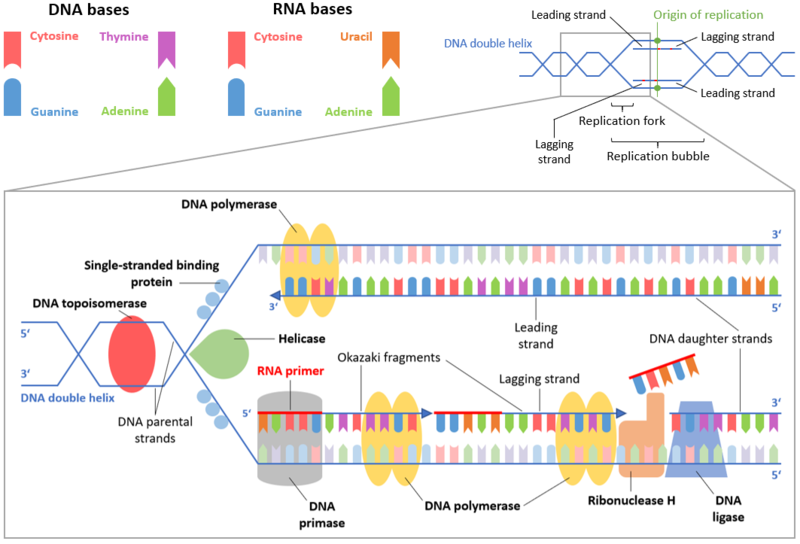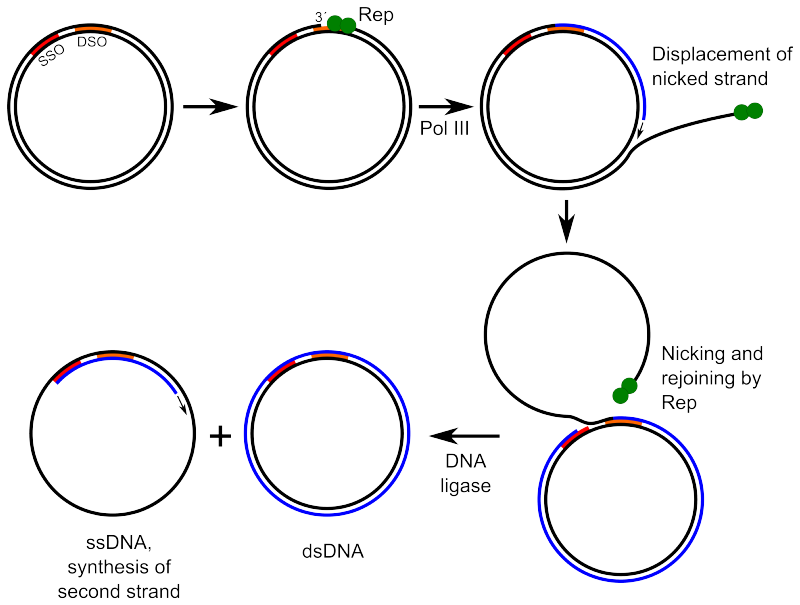Replication of DNA is the process of synthesis of new DNA molecules which are similar to parental DNA.
Replication of DNA is nothing but the process of duplication of DNA or genetic material from the parental DNA to form new DNA during cell division. The synthesized strands are indistinguishable to the parental DNA. In this article the DNA replication steps and DNA replication process are discussed in detailed.
DNA replication process:
The replication of DNA takes place in 3 steps.
Initiation:
This is the first step in DNA replication process. DNA replication is initiated at particular point in genome which is known as origin of replication. This origin of replication contain specific genes. The initiator proteins target the origin of replication by forming a replication complex around DNA replication origin point.
In DNA molecule many replication origin point are present which are commonly termed as replication forks. DNA helicase enzyme plays a vital role in the process of unwinding the DNA molecules. These strands act as a template in replication. This process consumes ATP molecule for forming the bind between nucleotide bases.
The RNA primer is synthesized by DNA primase enzyme. The RNA primer plays a crucial role in activation of DNA polymerases. DNA polymerases are very important in the formation of new DNA molecules.
Elongation:
In bacterial and human cells 5 different types of DNA polymerase enzymes are present. DNA polymerase is the only enzyme that has the capability of adding primers to the newly synthesized strand called leading strand and lagging strand. The bases are added without any break in leading strand, complementary to the template strand.
In the leading strand synthesis the bases are added to 3’ end and replication takes place in 3’ to 5’ direction. DNA has four bases like adenine, thymine, guanine and cytosine. Complementary pairing means that if adenine presents in parental strand the new strand takes thymine and if it has guanine the new strand takes cytosine and vice versa. As the pairing should be Adenine with thymine and guanine with cytosine (A-T and G-C).
In another template strand which is antiparallel the new DNA strand synthesis can occur in fragments called okazaki fragments in 5’ to 3’ direction this strand is known as lagging strand. As the DNA polymerase cannot read in 5’ to 3’ direction. The DNA polymerase adds RNA primers to the lagging strand exposed bases.
Termination:
The replication is continued up to meeting of two replication forks at a point. If the replication forks meet the DNA replication will be terminated. The termination is not controlled by any enzymes. After completion synthesis process the new strands are bound and the lagging strand or template (5’ to 3’) requires RNAase H or exonuclease and DNA ligase enzymes.
RNAase H removes RNA primers and these are replaced with bases according to the original coding in the lagging strand. The okazaki fragments are joined by the enzyme called ligase. The end of template strand contain repeated sequence known as telomers. These are helpful for providing protection at the end of chromosome to prevent fusion of chromosomes. The telomers are synthesized by the enzyme called telomerase. After completion of synthesis process the template strand and its complementary new strand coil around to form double helix structure.
DNA Replication Process Diagram:

DNA replication in prokaryotes:
The DNA replication takes place cell division process.
In prokaryotes the replication takes place in the following steps.
Rolling circular replication:

D- Loop replication:
D-loop replication is commonly takes place in mitochondria and chloroplast.
One of the two strands in plasmids has heavy nucleotides called heavy strand which is comprised of purines, adenine and guanine. Another strand is made of lighter nucleotides called light strand which is comprised of pyrimidine, thymine and cytosine.
D-Loop is formed in the heavy strand which is also known as control region. D-loop is a part of circular DNA which contains three strands. The middle strand is removed which is complementary to the light strand and the new strand synthesis takes place and remains until the completion of synthesis of heavy strand. The replication of light strand is started in opposite direction to the heavy strand after reaching the replication fork by the heavy strand.
DNA replication process in Eukaryotes:
In eukaryotes the replication process occurs in cell division process mainly during mitosis in the nucleus. In this S-phase the total genome should be unwound and undergoes replication to form daughter cells.
In eukaryotes the DNA replication occurs mainly in three steps.
These are discussed earlier in detail.
In eukaryotes DNA replication is a semiconservative replication.
Main points in Eukaryotic DNA replication:
DNA semi conservative replication process:
Semi conservative DNA replication means that in double stranded DNA molecule one strand is a parent strand and another strand is a newly synthesised strand coil around to make a double helix structure after complication of replication process.
This type of replication plays a key role in the transformation of genetic material from one generation to another generation.
This also supports the prevention of mutations.
Read More On: DNA Structure | A detailed insight with all crucial aspects.
Bacterial DNA replication steps:
In bacteria the small portion of the chromosomal DNA is replicated.
In bacteria the small portion of the chromosomal DNA is replicated.
As like eukaryotic DNA replication the bacterial DNA gets replicated in four steps.
Step 1: In this step the DNA molecule is unwound into two single strands to form a replication fork.
Step 2: Primase enzyme attaches RNA primers to the newly synthesised strand.
Step3: DNA polymerase enzyme adds the bases to the new stand.
Step4: After completion of the replication process the replication is terminated and the okazaki fragments are joined together by ligase enzyme.
- 7 Catabolic Enzyme Example: Detailed Facts
- 3 Passive Transport Examples: Explanation You Should Know
- 5 Phytoplankton Examples: That You Should Know
- 11 Epigynous Flower Example: Detailed Explanations And Images
- 15 Complete Flower Example: Detailed Explanations And Images
- 3+ Genetic Diversity Types: How To Increase Genetic Variation
Also Read:
- Biennial plant example
- Forest ecosystem example
- Tick examples
- Are bacteria herbivores
- Chloroplast structure
- Archaea examples
- Do prokaryotes have enzymes
- Intermediate species examples
- Obligate parasite
- Do bacteria have lysosomes

Hi…I am Nagasrilakshmi Narne, a postgraduate in Biotechnology and English. also completed my B.Ed. I worked in Vimtalabs as a project trainee and I have work experience as a faculty of English. So I can explain topics in simple language.
Let’s connect through LinkedIn